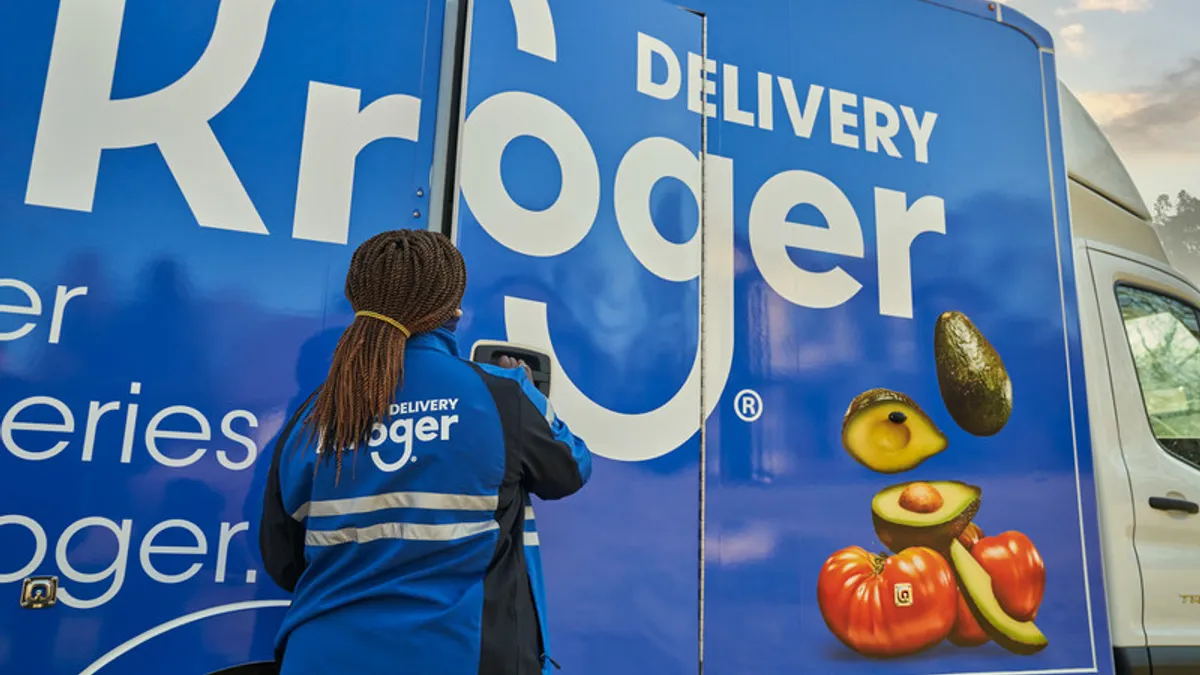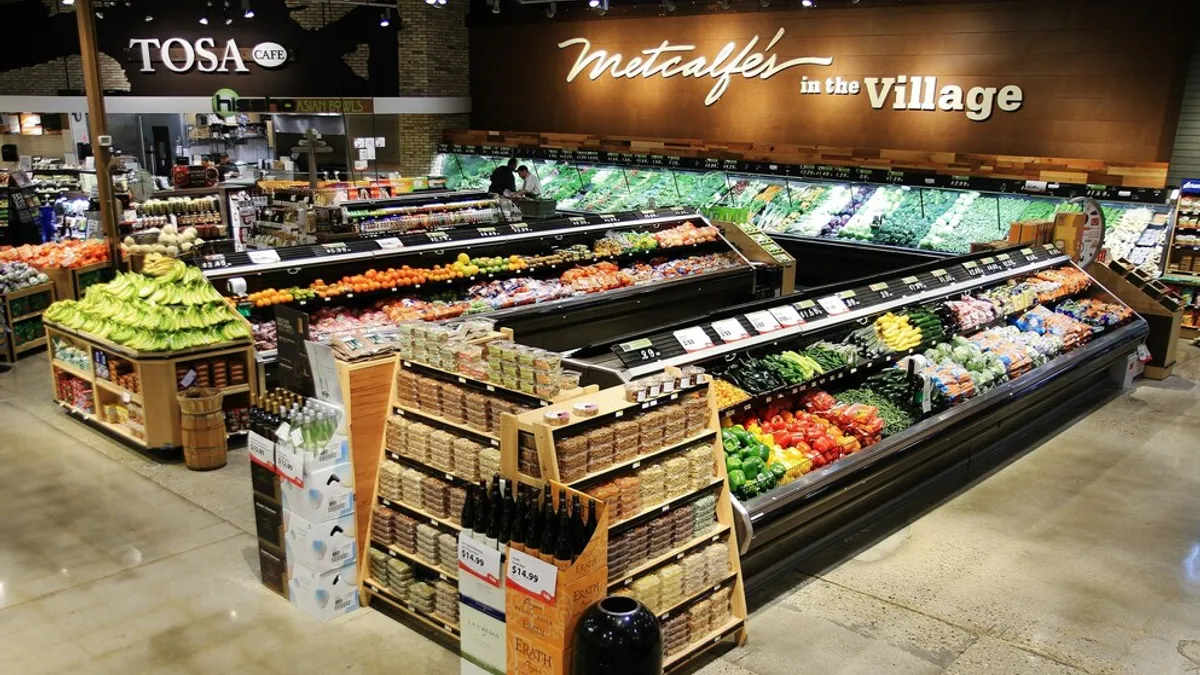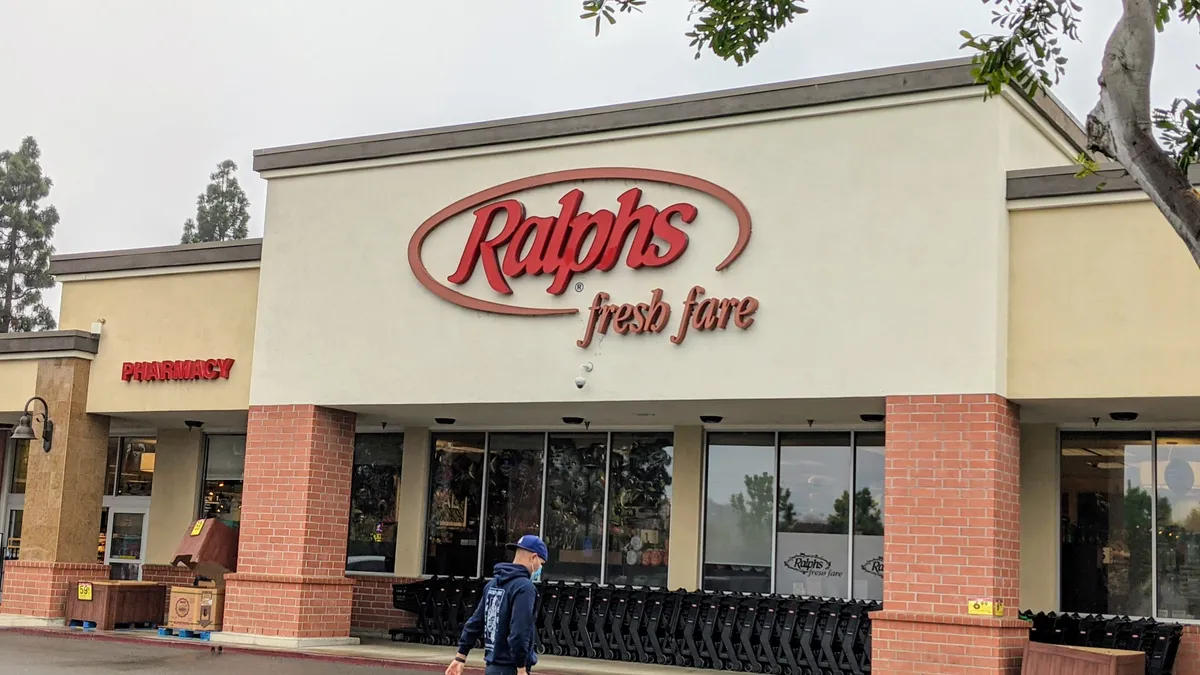Pardon the Disruption is a column that looks at the forces shaping food retail.
With its planned $24.6 billion acquisition of Albertsons announced late last week, Kroger is making clear it doesn’t intend to let Walmart and Amazon continue enjoying the greatest benefits of scale in the grocery industry.
Kroger is no small enterprise, of course. It’s the country’s largest supermarket chain, with loads of stores and a raft of alternative businesses circling that core grocery offering. But it still labors to keep up with the prices and the pace of innovation that Walmart and Amazon set because it hasn’t had that next-level scale of those two companies, which dominate the bricks and clicks, respectively, of retail. And that pressure is only going to grow in the coming years as digital shopping and the ecosystems that support them continue to ramp up.
If it’s able to merge with Albertsons (more on that if further down), Kroger will be able to pull itself within striking distance of the industry behemoths. It also leaves the rest of the country’s grocery chains in the dust, effectively creating a new “Big 3” in the industry.
There’ll be Walmart, Amazon, Kroger/Albertsons, and then everyone else.
Fueling digital and alternative businesses
The deal says a lot about the state of the industry today. As inflation and supply chain headaches continue to impact retailers, Kroger’s acquisition gives the company more operational resources, including expanded private label capabilities and more negotiating power with suppliers. Kroger estimates the deal will achieve $1 billion in annual efficiency savings within the first four years of its completion.
It also presents the opportunity to build out a truly nationwide supermarket network with a rationalized store footprint. Kroger, which currently doesn’t operate stores in the Northeast and Northern California, will now have access to those markets through Albertsons stores. The stores that operate in close proximity — in some cases right across the street from each other — can be jettisoned, either voluntarily or through the coming regulatory review process.
Beyond these traditional benefits that come with a large merger, Kroger’s acquisition incorporates scale benefits in emerging areas like data, e-commerce and retail media that add even more value to the tie-up than we would have seen even just a few years ago, and further position it for the years to come.
Four years after announcing its moonshot e-commerce deal with Ocado, Kroger now stands to drive more volume through the fast-growing network of automated warehouses it’s building alongside the British e-grocer and technology company. High volumes are critical to making those pricey facilities cost effective, and Kroger was probably overly optimistic about the amount of orders it could push through those facilities on its own, Stewart Samuel, program director with IGD, told me. Kroger’s flexible agreement with Ocado also means the companies can build additional facilities as needed.
Albertsons has mainly outsourced its delivery operations in recent years to third-party marketplaces, but it has deep experience testing automated micro-fulfillment centers (MFCs) that could help round out Kroger’s network. The combination of small, medium and large facilities will likely be crucial to helping Kroger compete with Walmart, which has its cavernous stores and a newly acquired MFC company to lean on for fulfillment, and Amazon, which is adding same-day delivery through its fast-growing store network.
“Kroger has always said they want to have that range of options in e-commerce fulfillment. I think the two [approaches] are not incompatible,” Samuel said.
Greater scale also boosts Kroger’s ability to compete with Walmart, Amazon and Instacart for supplier advertising dollars that help support those hefty e-commerce investments. The more shoppers a retailer serves, the greater the pull they have in retail media. Kroger has built a leading retail media business over the years that could help the combined company capitalize on the 85 million combined households they serve.
Alternative revenue streams like retail media, health services and consumer insights are becoming critical for retailers as expenditures in e-commerce, sustainability and other investments further dilute their margins over time, said Samuel. That adds even more impetus to scale up.
The greatest prize in the merger, then, might be the reams of additional consumer data Kroger can crunch to fuel its core business and alternative streams, said Ken Fenyo, president of research and advisory with Coresight Research and former vice president of loyalty and digital with Kroger.
“Kroger has a huge data set of national consumer behavior data, to which they apply analytics, personalization, and expertise to drive retail media, personalized marketing, and better internal decision making,” he wrote in emailed comments. “Data is the real gold in the deal.”
During a call with the investment community on Friday, Kroger’s Chief Financial Officer Gary Millerchip noted the deal will enhance the “flywheel effect” the grocer has harnessed in recent years, wherein its core grocery business helps fuel its alternative businesses, which in turn power further investments in the core. He estimated a combined Kroger-Albertsons will immediately generate $1.5 billion in yearly profit from alternative businesses, up from the $1 billion Kroger reported last year.

Will a deal actually get done?
For all its potential to create a new industry behemoth, there are a lot of questions swirling around this deal. Chief among them being: Will the deal actually go through?
The Federal Trade Commission has blocked mega mergers in the past, including the proposed joining of US Foods and Sysco in 2015, and Staples’ bid to acquire rival Office Depot that same year. Experts agree the FTC now takes a more critical look at large deals that could stifle competition and raise prices.
Samuel said he’s skeptical the FTC will let the two largest U.S. supermarket companies merge, given their overlaps and the fact that both businesses have been doing quite well on their own. Wall Street is also treading carefully around the deal, noting its game-changing nature but also pointing out the extensive risk involved. Kroger’s shares fell just over 7% on Friday and Albertsons’ shares fell 8.5%, indicating investors aren’t confident will make it through regulatory approval.
“While we understand the benefits from acquiring Albertsons … such benefits only play out if the merger passes FTC scrutiny,” Jefferies analyst Rob Dickerson wrote in a note to investors on Friday.
Kroger will certainly need to sell the FTC on the deal’s ability to lower prices, improve services and not stifle competition — a tall task, no doubt. Fenyo said he’s optimistic the deal will get approved, noting that Kroger has already said it plans to plow $500 million into price investments off the bat.
"Data is the real gold in the deal."

Ken Fenyo
President of research and advisory, Coresight Research
Kroger has said it’s prepared to sell off anywhere from 100 to 375 stores to satisfy regulatory requirements. That projection seems more like an opening bid than a realistic range, given the many markets across the U.S. where the two compete and have leading market share.
In a note to investors, Wells Fargo analyst Edward Kelly noted that Kroger will be able to pay a $600 million breakup fee if it’s required to divest more than 650 stores. “It's difficult to know if an FTC ruling would breach this threshold, but we still expect a high number of divestitures given it may be difficult to find a buyer without providing adequate local scale,” he wrote.
In Southern California alone, the two companies have five combined banners — Kroger’s Ralphs and Food 4 Less chains, and Albertsons’ Safeway, Vons and Pavilions brands. In the Seattle area, where I live, Safeway stores and Kroger’s Fred Meyer and QFC stores constitute the top three grocers in terms of store traffic, according to Placer.ai. In Chicago, Albertsons’ Jewel-Osco and Kroger’s Mariano’s stores are the top two grocers, according to that same metric.
There are other questions surrounding the head-spinning complexities of combining two sprawling supermarket operators. How would Kroger and Albertsons handle private labels, given Kroger’s out-and-out strength in this area? Will Kroger want to inject its massively successful Simple Truth and Home Chef brands into Albertsons’ stores? Can those brands coexist with Albertsons brands like Open Nature and ReadyMeals?
Both Kroger and Albertsons have developed strong test-and-learn approaches to food retailing, ushering in innovations like ghost kitchens, automated e-commerce ordering, robotic fulfillment and more. How will the companies combine their innovation capabilities? And how will they continue to source the local and niche products that consumers still greatly value as they grow to nearly 5,000 stores?
It’s also worth considering the effect a Kroger-Albertsons merger would have on the rest of the industry. I recently predicted in this column an uptick in regional grocery M&A — an uptick driven by the rising pressure that major players like Walmart and Amazon are exerting on the industry. If a third mega grocer joins the mix, that pressure rises even more, leading to what could easily become a feeding frenzy of consolidation in food retail.























